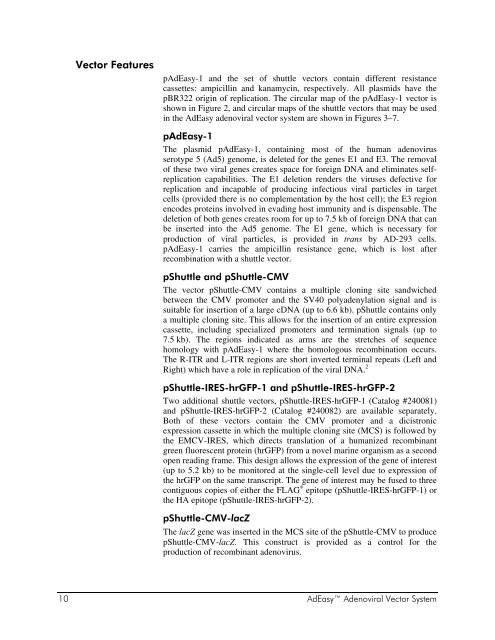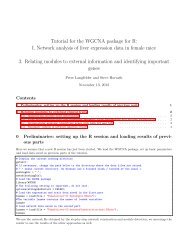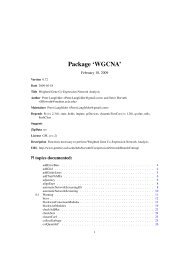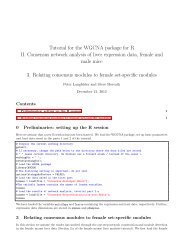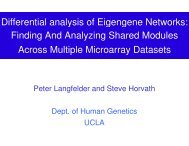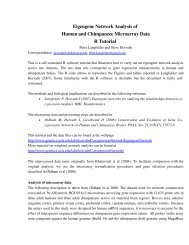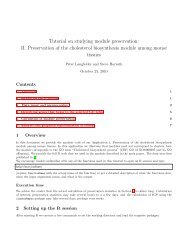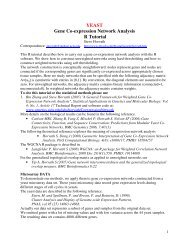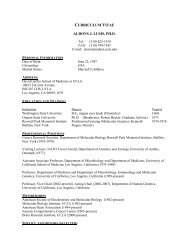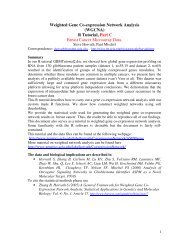Manual: AdEasy Adenoviral Vector System - UCLA Human Genetics
Manual: AdEasy Adenoviral Vector System - UCLA Human Genetics
Manual: AdEasy Adenoviral Vector System - UCLA Human Genetics
You also want an ePaper? Increase the reach of your titles
YUMPU automatically turns print PDFs into web optimized ePapers that Google loves.
<strong>Vector</strong> Features<br />
p<strong>AdEasy</strong>-1 and the set of shuttle vectors contain different resistance<br />
cassettes: ampicillin and kanamycin, respectively. All plasmids have the<br />
pBR322 origin of replication. The circular map of the p<strong>AdEasy</strong>-1 vector is<br />
shown in Figure 2, and circular maps of the shuttle vectors that may be used<br />
in the <strong>AdEasy</strong> adenoviral vector system are shown in Figures 3–7.<br />
p<strong>AdEasy</strong>-1<br />
The plasmid p<strong>AdEasy</strong>-1, containing most of the human adenovirus<br />
serotype 5 (Ad5) genome, is deleted for the genes E1 and E3. The removal<br />
of these two viral genes creates space for foreign DNA and eliminates selfreplication<br />
capabilities. The E1 deletion renders the viruses defective for<br />
replication and incapable of producing infectious viral particles in target<br />
cells (provided there is no complementation by the host cell); the E3 region<br />
encodes proteins involved in evading host immunity and is dispensable. The<br />
deletion of both genes creates room for up to 7.5 kb of foreign DNA that can<br />
be inserted into the Ad5 genome. The E1 gene, which is necessary for<br />
production of viral particles, is provided in trans by AD-293 cells.<br />
p<strong>AdEasy</strong>-1 carries the ampicillin resistance gene, which is lost after<br />
recombination with a shuttle vector.<br />
pShuttle and pShuttle-CMV<br />
The vector pShuttle-CMV contains a multiple cloning site sandwiched<br />
between the CMV promoter and the SV40 polyadenylation signal and is<br />
suitable for insertion of a large cDNA (up to 6.6 kb). pShuttle contains only<br />
a multiple cloning site. This allows for the insertion of an entire expression<br />
cassette, including specialized promoters and termination signals (up to<br />
7.5 kb). The regions indicated as arms are the stretches of sequence<br />
homology with p<strong>AdEasy</strong>-1 where the homologous recombination occurs.<br />
The R-ITR and L-ITR regions are short inverted terminal repeats (Left and<br />
Right) which have a role in replication of the viral DNA. 2<br />
pShuttle-IRES-hrGFP-1 and pShuttle-IRES-hrGFP-2<br />
Two additional shuttle vectors, pShuttle-IRES-hrGFP-1 (Catalog #240081)<br />
and pShuttle-IRES-hrGFP-2 (Catalog #240082) are available separately.<br />
Both of these vectors contain the CMV promoter and a dicistronic<br />
expression cassette in which the multiple cloning site (MCS) is followed by<br />
the EMCV-IRES, which directs translation of a humanized recombinant<br />
green fluorescent protein (hrGFP) from a novel marine organism as a second<br />
open reading frame. This design allows the expression of the gene of interest<br />
(up to 5.2 kb) to be monitored at the single-cell level due to expression of<br />
the hrGFP on the same transcript. The gene of interest may be fused to three<br />
contiguous copies of either the FLAG ® epitope (pShuttle-IRES-hrGFP-1) or<br />
the HA epitope (pShuttle-IRES-hrGFP-2).<br />
pShuttle-CMV-lacZ<br />
The lacZ gene was inserted in the MCS site of the pShuttle-CMV to produce<br />
pShuttle-CMV-lacZ. This construct is provided as a control for the<br />
production of recombinant adenovirus.<br />
10 <strong>AdEasy</strong> <strong>Adenoviral</strong> <strong>Vector</strong> <strong>System</strong>


